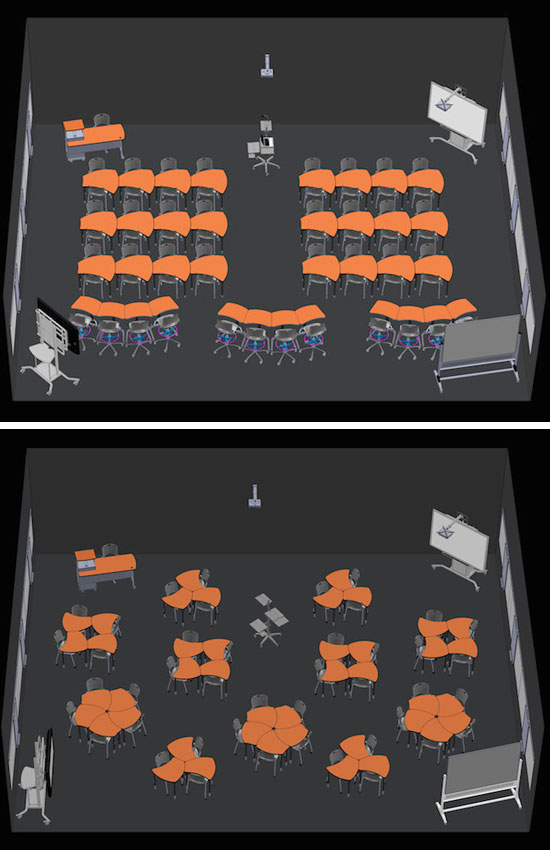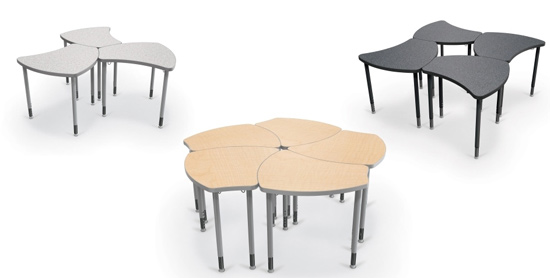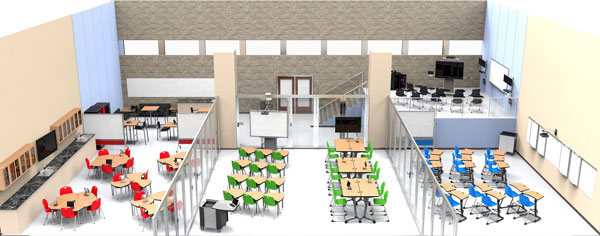Designing Schools for a Modern Learning Environment
How Furnishings in Classrooms Can Add to a Superior Learning Environment

Illustrations courtesy of MooreCo Inc.
Two configurations for a 1,000-square-foot classroom. In the top image, the classroom is set up for a lecture environment, with all chairs facing the front of the room and the teacher or lecturer. In the bottom image, the desks and chairs are set up for small groups and teamwork activities. Configurations include three desks, four desks and five decks.
According to the report from the Canadian Center of Science, “Supportive space layouts with flexible seating arrangements enable different patterns of interaction, connect people with each other, and facilitate collaboration and teamwork.”
But, the report warns, “Unsupportive layouts, however, decrease such connection and interaction. Spaces that discourage interaction patterns are considered dull, empty, huge and meaningless. One example of such a notion is a back-to-back seating arrangement that prohibits teamwork and collaborative learning in classroom environments. Yet, seating arrangement in design-studio classroom is considered supportive when interaction among students/students and students/instructors is encouraged and collaborative learning is ensured.”
“Educational institutions ought to consider the importance of learning environments and their impact on the teaching/learning process; they should provide appropriate and supportive physical settings. The way the classroom is designed, according to Herman Miller, Inc., affects students’ inspiration, concentration, behavior, well-being and performance. Well-planned learning environments, in this regard the design-studio classroom, with flexible and comfortable furniture, appropriate lighting and temperature will positively support teaching/learning experience.”
Studio Configuration in Japan
According to the research on 21st-century education by the Rand Corporation discussed earlier, Japanese educators are trying out an experimental learning system called the “studio learning,” which is designed to teach students to think, analyze and question. These are all skills they will need in the real world.
In the studio system, small pods of students work to solve a problem. It could be an engineering problem, or something to do with robotics, or technology or another discipline.
As the pods of student work through the problems, the other students observe the process. An analogy would be a studio artist or studio musician working on a project as others observe.
When the problem is worked through in the classroom, the observers query each team with questions such as: Why did you solve it in this way? Did you consider other solutions? And so on.
The ability to easily configure the classroom for a studio learning session would be a great benefit to the teaching technique. Ironically, because the studio teaching method requires a lot of students—both as team members and observers—some Japanese educators worry about class sizes getting too small (which is often the holy grail of U.S. teachers) because fewer students means fewer new and innovative ideas to discuss and debate.

Flexible desk configuration is key to encouraging collaboration. Here are some desk layout scenarios.
Desk Layout Options
Independent study or learning—The single desk configuration is for independent study when students need to focus on their own projects, like taking tests. It’s also useful for lining up desks to face in one direction to watch a presentation, a video or listen to a speaker.
• Pairs of students —some exercises and study plans call for students to work in pairs, perhaps to solve a problem. Two desks joined provide a physical unit that helps students focus on each other rather than the rest of the class.
• Pods of students—in certain cases, a learning exercise calls for pods of students to work together. This could be anywhere from three to 10 or more students. When designs are easily arranged into the pod configuration, students can focus on their own teams.
• Team setting—a pod of four students.
• Project-based setting—a pod of five students.
• Advisory setting—a pod of three students.
• Stadium setting—for lectures.
• TEAL (Technology Enhanced Active Learning)—a pod of nine students.
Configuration for STEM Teaching
STEM is an acronym for Science, Technology, Engineering and Math. A great movement is underway in the United States to teach these four subjects in relation to each other, rather than as separate, unrelated subjects.

Illustration courtesy of MooreCo Inc.
These various STEM classrooms are set up for lecture style seating and various teamwork seating arrangements. Often, computer stations are included. The key for new learning environments is the ability to easily reconfigure classrooms according to the needs of the lessons, and to foster connections between the teacher and students, and between students.
In a STEM classroom, there are typically three distinct areas that make up the learning environment: traditional lecture style seating, teamwork seating and computer stations, paralleling the way forward-thinking technology and engineering businesses operate.
“By coordinating science and math courses with technology and engineering courses, teachers can give students a better understanding of the world in which they live,” states the National Science Teachers Association (NSTA).vii “Few of today’s students understand the way in which these fields benefit our society or the variety of career opportunities that are available to them.”
Making Learning Relevant to Real Life via Sports-Themed Videos
In addition, students need to connect what they are learning in their classroom with what is happening in their world today. Sports-themed educational videos have been created by NBC in association with the National Science Foundation. Rather that trying to get students to leave their sports obsession at the door of the classroom, why not tap into that for a high-powered learning experience?
Sports-themed topics and videos include:
Science and Engineering of the 2014 Olympic Winter Gamesviii
• Stability & Vibration Damping in Alpine Skiing
• Shani Davis & Engineering Competition Suits
• Science of Ice
• Olympic Movement & Robotic Design
• Building Faster & Safer Bobsleds
Science of NFL Footballix
• Pythagorean Theorem
• Kinematics—Position, Velocity & Acceleration
• Nutrition, Hydration & Health
• Projectile Motion & Parabolas
• Newton’s First Law of Motion
To make it possible to teach such multidisciplinary topics, classrooms should be set up accordingly.
STEM-oriented classrooms need enhanced technology and a flexible set up.









